In this Meeting Note, Mridula N and Darsana S discuss what they learned from an online course on ‘Design Thinking in Agricultural Research and Education’, which was hosted by ICAR-NAARM, Hyderabad, India.
CONTEXT
Design Thinking (DT) is a paradigm that emphasizes the user and is praised for the way it frames issues, uncovers unmet needs, and blends user feedback into processes and systems. The human-centered, ‘open’ issue-solving method that decision makers employ to tackle distressing challenges in the actual world are increasingly being referred to as ‘design thinking’. There have been claims that using design thinking in this way can significantly enhance decision making not only in product innovation but also in other domains, including management, public health, and organizations. Product design and development processes use design thinking as a tool to drive innovation and to structure creation processes in a variety of disciplines, from social science research to cuisine production and product development. In short, design thinking is becoming more and more prevalent beyond the boundaries of creative and design disciplines and making inroads into the domain of problems in social and ecological systems.
A five-day online training programme on ‘Design Thinking in Agricultural Research and Education’ was organised from 09-13 October 2023, by ICAR-National Academy of Agricultural Research Management (NAARM), Hyderabad, for mid-career researchers, faculty members, and research students from ICAR institutes and state agricultural universities. A dynamic group of nearly 50 participants attended the online training.
The training was designed with the objectives of building design thinking (DT) perspectives among researchers and educators using specially designed web-based open-access software, and developing competence in implementing research ideas and delivering education with empathy, involving clients and other stakeholders who can uphold DT processes.
OVERVIEW OF DESIGN THINKING
Dr SK Soam, Principal Scientist and Former Head, ICM Division, ICAR-NAARM, Hyderabad, opened the online course by providing a succinct overview of the course, including design thinking principles.
The cornerstone of design thinking is empathy, or trying to see things from other people’s perspectives by considering what they would need or want. Here, the limitations of current solutions are understood on a personal level. The other essential principles include: defining a meaningful and action-oriented problem statement, ideating – which involves questioning presumptions and generating novel solutions; prototyping – which involves starting the process of solutions creation, and testing those solutions in real-world scenarios. Social impact is design thinking’s overarching objective. Therefore, it is critical to comprehend the viability, attractiveness, and feasibility of initiatives and activities that lead to deliverables because it is via design thinking that the benefits are made possible. Thinking creatively is more than just a way of thinking, it is also a process that is collectively moulded by social or organizational norms, history, and culture. The application of design thinking involves several key activities, including teamwork, journey mapping, emotional intelligence, need analysis, and network analysis. On the subject of agricultural research and education, the variety of environments can be viewed as both a source of creative ideas and as design processes. Applying these strategies to contexts akin to system thinking is made possible, regardless of the context, by the ‘Client needs Assessment’, which helps in prioritizing the easiest alternative with the most value and selecting the optimal action.
A holistic approach to design thinking has applications in business, engineering, and education. It involves adopting a certain DT toolkit (skill) and cultivating a particular DT mentality (attitude), both of which would greatly enhance the perception of a given topic’s specialization, regardless of the application field. It is possible to create and carry out projects and research initiatives in a discipline-neutral manner using design thinking and the knowledge-skill-attitude framework. Therefore, in order to increase their efficacy while creating and implementing research, teaching, and management projects, researchers must acquire design-thinking skills. The training programme ought to be the initial step towards implementing DT ideals.
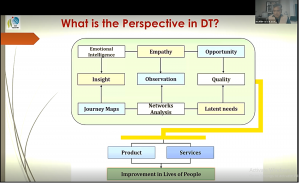 Perspectives in Design Thinking
Perspectives in Design Thinking
KEY LEARNINGS
Design thinking in education, innovation and extension
Design thinking has applications in education that can improve curriculum development and raise the calibre of instruction. Effectiveness in education depends on how well the objectives are defined. For this reason, it’s critical to distinguish between the results of teaching design thinking and those of integrating it into educational environments. Design thinking pushes people to think with their hands and bodies, fostering tactile experiences, boosting empathy, decreasing cognitive bias, fostering playful learning, generating fast-paced, flow-producing work, stepping outside of comfort zones, embracing constructive failure, having faith in the process, and sharing amazement.
One essential component of the design-thinking approach to innovation is that it promotes inter- and trans-disciplinary collaboration in multidisciplinary teaming. By fostering unrestricted imagination, resilience, and the creation of surprising and delightful solutions, design thinking fosters confidence. The common themes shared by design thinking in formal education settings and higher education include course material development, creating curricular development techniques, teaching strategy to achieve subject-specific learning goals, and as a learning goal in and of itself. Moreover, it can be used as a facilitation technique for student support, such as mentoring, advising, and counselling. It’s also a strategy for developing new products or processes as well as a method for leadership and organizational development.
In the extension discipline, design thinking can be used for user interviews, observation, surveys, empathy maps, mind mapping, prioritization matrix, brainstorming, and even more to comprehend user demands, motivations, behaviours, and viewpoints while also identifying areas for innovation. In addition to creating sustainable agricultural methods, it can also streamline supply chains, provide farmers with the knowledge they need to make wise decisions, increase yields and profitability while having the least negative effects on the environment, and to create campaigns and strategies for market research. By providing real-time weather information, crop management guidance, market pricing information, crop yields and quality, value chains, and market trends, design training can enhance communication among various stakeholders and facilitate the provision of tailored product recommendations and individualized customer care. Prototypes can be created and tested with people, and technology can employ design thinking to collect and analyse data on consumer behaviour and market trends. It also makes it easier for stakeholders to work together and reach consensus. Regardless of the field, design thinking can be applied more broadly and have a greater impact on extension operations. This can foster growth and innovation by helping people discover opportunities and challenges together and then working collectively to co-create solutions that are advantageous to all.
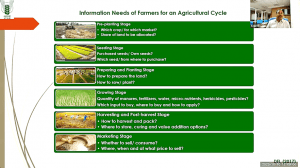 Information needs that are crucial for farmer-centric design thinking
Information needs that are crucial for farmer-centric design thinking
Design thinking in research and projects
Design thinking aims at transcending the immediate boundaries of the problem to ensure that the right questions are being addressed. To make sure that the correct questions are being asked, design thinking attempts to go beyond the problem’s immediate boundaries. The brainstorming technique promotes a creative, entrepreneurial research approach by allowing freedom and placing the greatest emphasis on problem solving. By enhancing the research process, design thinking can produce more creative scientists capable of producing high-calibre work systematically applying their creativity to the advancement of their respective fields of study. To investigate potentially problematic solutions, one must be aware of their research approach, work habits, and emotional state. When combined with analytical and scientific methods, DT helps research concepts become reality through carefully laid out procedures. DT tools can help with prototype development, iterative process understanding, and feedback gathering for future research development. Consequently, researchers can effectively handle ambiguity; apply analytical abilities, creative intelligence, and emotional well-being, all while being proactive in attending to their own emotional needs.
Research Conceptual Writer (RCW), Project Logframe Writer, and Analytic Hierarchy Process (AHP) analyzers are some of the tools that support the use of DT concepts in the research process. A well-crafted research question, which is the result of a carefully thought-out problem statement, can be created using the RCW tool and is important for successful project implementation and effectiveness. Project structure, means of verification (MOV), objectively verifiable indicators (OVI), critical assumptions (for success and failure), and risks pertaining to inputs, outputs, activities, and resources are all addressed by the Project Logframe Writer. Collaborative decision making using the AHP Analyser facilitates the ranking of options. These tools impact technology value and management, research project monitoring and evaluation (PME), priority setting, and project prioritization.
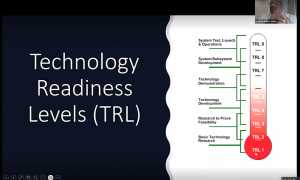 A slide showing Technology Readiness Levels (TRLs) in projects
A slide showing Technology Readiness Levels (TRLs) in projects
Design thinking in management
The importance of design thinking (DT) for start-ups and ecosystems was highlighted in the session ‘Design thinking from management perspectives’ led by Dr K Srinivas, NAARM. Particular attention was paid to the processes of inspiring (problem identification), ideating (prototyping), and implementing (using the best functional prototype). A fascinating talk on how design thinking is applied in team building for research and management was delivered by Dr RVS Rao. During the design phase, communication among the members and comprehension of the teams’ capacities to identify uncertainty are important. Lack of group leadership, issues with fair task distribution, and the potential negative impact of team size on management are the main causes for the tensions around collaboration. Design solutions to institutional and personal problems can be generated collaboratively with the design thinking paradigm, resulting in real, cross-disciplinary knowledge. The main factor influencing the acquisition of design thinking is multi-disciplinary teamwork in practice. This is frequently connected to personal and intercultural elements and indicates the collaborative culture of the organization.
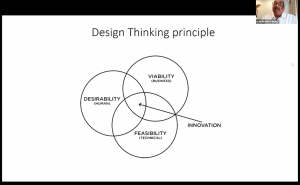 Principles of Design Thinking
Principles of Design Thinking
Design thinking for farmer collectives and agribusinesses
For agribusiness companies to survive, aggregation through FPOs is crucial. Design thinking in agriculture can assist agribusinesses in creating sustainable methods that reduce their negative effects on the environment while guaranteeing long-term financial success. Developing new goods that address the changing demands of farmers and consumers is another gain. Examples of these include soil testing kits, precision agriculture tools, and alternative fertilizers. Supply chains can be made more efficient, less wasteful, and have better quality control by identifying their problems and developing solutions. In addition to empowering farmers to make more informed decisions that will increase their yields and profitability, design thinking can improve consumer experiences (satisfaction, loyalty, and advocacy).
By enhancing packaging, shipping, and storage techniques, as well as by coming up with creative uses for food by-products, design thinking can help reduce food waste in the supply chain and appeal to environmentally mindful consumers. Using design thinking, agribusinesses can create marketing campaigns, input management plans, and initiatives that improve traceability and transparency. Design thinking can be used to generate creative solutions to the problems caused by climate change. It can also assist agribusinesses in creating quality control and safety procedures that comply with regulations and boost consumer trust in their goods.
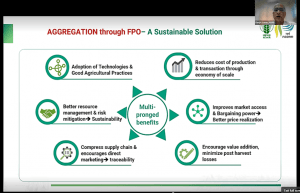 FPO aggregation paves the way for design thinking
FPO aggregation paves the way for design thinking
OBSERVATIONS
The sessions gave participants a deeper understanding of design thinking. Enterprises are using design thinking as a creative approach to make products or services that address difficult problems in their industries. The lectures and practical sessions handled by the experienced faculty members enabled participants to follow theoretical concepts of DT and its application in their respective areas. The training instilled design thinking abilities and gave participants the chance to put the DT principles into reality in small groups in a ‘social-technical environment’.
 Dr Mridula N, Assistant Professor (Agricultural Extension), Central Training Institute, Kerala Agricultural University. She can be reached at mridula.n@kau.in
Dr Mridula N, Assistant Professor (Agricultural Extension), Central Training Institute, Kerala Agricultural University. She can be reached at mridula.n@kau.in
 Dr Darsana S, Assistant Professor (Agricultural Extension), Central Training Institute, Kerala Agricultural University. She can be reached at darsana.s@kau.in
Dr Darsana S, Assistant Professor (Agricultural Extension), Central Training Institute, Kerala Agricultural University. She can be reached at darsana.s@kau.in

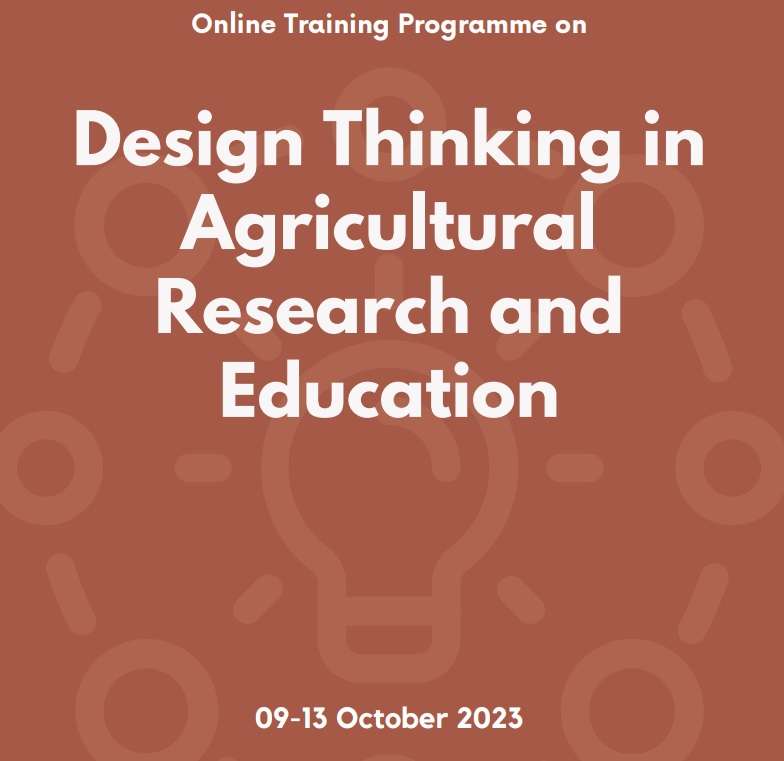

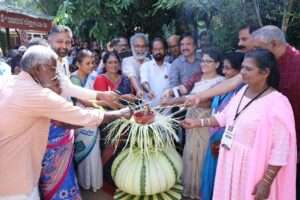

Add Comment